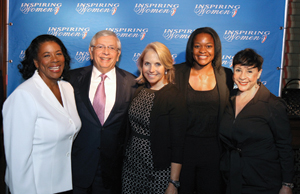There was a great deal of speculation that we were entering a post-civil rights era four years ago when the United States elected Barack Obama as its first African-American president. As the president seeks re-election, it is clear that we are not in a post-civil rights era.
We only need to review events of the last four months to see that clearly. Trayvon Martin, an unarmed 17-year-old African-American, was fatally shot in Sanford, Fla., in late February. In March, the Southern Poverty Law Center reported that there was a record high 1,018 hate groups in the United Sates. In early April, five African-Americans were shot in Tulsa, Okla.; three died in the race-based shootings. It has not been a good year for U.S. race relations. These are ominous signs.
As we seek good news to counter the bad, the world of sports continues to provide some highlights. This week, the Institute for Diversity and Ethics in Sport, of which I am the director, is releasing the 2012 NBA Racial and Gender Report Card. The NBA has been the industry leader for hiring practices for women and people of color since we started publishing the report cards 25 years ago. I have been the primary author throughout that period.
The league led by David Stern has been a model for the NFL, MLB and MLS among the men’s leagues and has received an A for racial hiring practices throughout the last 20 years. The NBA-created WNBA has been the best of all the pro leagues we cover. MLB and the NFL were earning C’s in the beginning; they broke in the B category in the mid-1990s and joined the NBA with A’s in the last few reports. The WNBA has gotten A’s since it was founded. MLB Commissioner Bud Selig and NFL Commissioner Roger Goodell are passionate about issues of diversity and inclusion and it shows in the recent improvements in the records of their leagues.
 |
The NBA’s diversity success includes the first black woman president of the WNBA, Laurel Richie (left), shown here with NBA Commissioner David Stern, broadcaster Katie Couric, WNBA player Alana Beard and Washington Mystics owner Sheila Johnson.
Photo by: NBAE / GETTY IMAGES
|
Here are some highlights from the most recent report cards, including the recently released NBA report card.
• For the first time in the NBA’s history, there were more head coaches of color than white head coaches. African-American head coaches represented 47 percent of all NBA head coaches, the highest percentage since the 2001-02 season. Kaleb Canales became the first Latino head coach in the history of the NBA upon his promotion by the Portland Trail Blazers to interim head coach in March. Heat coach Erik Spoelstra remained the only Asian NBA head coach for the fourth consecutive season.
• The number of African-Americans in NBA ownership groups has increased to include Michael Jordan with the Charlotte Bobcats; Will Smith, Jada Pinkett Smith and James Lassiter with the Philadelphia 76ers; Fred Jones and Elliot Perry with the Memphis Grizzlies; and Sheila Johnson with the Washington Wizards. The NBA’s first Asian owners, Erick Thohir and Handy Soetedjo, are a part of the Sixers ownership group. Raul Fernandez with the Washington Wizards is the only Latino owner in the history of the NBA.
• At the beginning of the 2011-12 regular season, there were seven African-Americans and two women CEOs and presidents in the NBA.
• WNBA President Laurel Richie last year became the first female of color to be named president of a professional sports league.
• For the 2011 season, 42 percent of the WNBA head coaches were African-American.
• There are two teams in MLB owned by persons of color. Arte Moreno maintains his position as the owner of the Los Angeles Angels. The ownership group of the Los Angeles Dodgers now includes Magic Johnson, who is the face of the team although not the majority owner.
• For the start of 2012, Major League Baseball had five managers of color, one less than in 2011. There are two African-American and three Latino managers.
• In our colleges, there has been great news for head football coaches, with 19 head coaches of color among the 120 FBS schools, a 600 percent increase from 2003.
There are certainly significant areas in each of the leagues and even more in our colleges where there is room for improvement, especially at the team levels. But as can be seen with these highlights, there is good positive news in many of the most important positions.
I have seen so many examples of how race relations can be improved in communities with the simple acts of the athletes on professional or college teams. Teams that are engaged with their fans are always more appreciated. That is more likely to happen when you have something like NBA Cares. The organization’s public service announcements during the NBA playoffs have been moving and effective. The LeBron James commercial about the dangers of not doing well in school and dropping out is very powerful. The breakthrough series of Major League Baseball ads and PSAs on homophobia and bullying were a dramatic departure from those produced in the past. When athletes are willing to speak out, people look up to them and listen to them.
In post-Katrina New Orleans, there were bitter feelings about race relations in the African-American community, which suffered more than any other group in the hurricane’s aftermath. The Lower Ninth Ward, where the core of the African-American population lived, was virtually destroyed and has yet to come back in ways that residents would hope. For me, the most hopeful and important days since Hurricane Katrina were when the Saints came home to the Superdome; the NBA All-Star Game and the NBA’s Day of Service; and, finally, when the Saints won the Super Bowl in 2010. Suddenly, it didn’t matter what the skin color of the player or fan was, what religion they believed in, or whether they were rich or poor. Things were beginning to change. Hope was being restored.
In a sports-loving nation still trying to rid itself of the pain caused by racism, these improvements in sport can help give hope.
Richard E. Lapchick (rlapchick@bus.ucf.edu) is the chairman of the DeVos Sport Business Management Graduate Program and the director of the Institute for Diversity and Ethics in Sport at the University of Central Florida.





